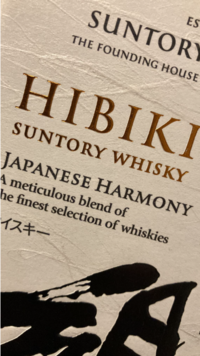Hibiki 12Y

Japanese whisky has seen a remarkable rise in popularity over the years, and one of the most iconic bottles that has captured the attention of enthusiasts worldwide is the Hibiki 12 Year Old. This blend is a sublime representation of Japan's approach to craftsmanship, with a careful balance between tradition and innovation. In this comprehensive blog, we’ll dive deep into the world of Hibiki 12, exploring its background, production process, and the unique flavor profiles that make it one of the most sought-after whiskies in the world.
The History of Hibiki and Suntory
The origins of Hibiki 12 lie in the rich history of Suntory, one of Japan's oldest and most prestigious whisky brands. Suntory was founded in 1899 by Shinjiro Torii, who initially ran an import business for Western wines and spirits. However, he dreamed of creating his own Japanese whisky that would perfectly complement the delicate flavors of Japanese cuisine. In 1923, he built Japan's first whisky distillery in Yamazaki, near Kyoto. This distillery would become the starting point for what is now a global phenomenon.
Suntory is responsible for some of the best Japanese whiskies, such as Yamazaki and Hakushu. Hibiki was introduced in 1989 to celebrate Suntory's 90th anniversary and was intended to be a luxury blend that encapsulated the essence of Japanese whisky. Hibiki, which means "harmony" in Japanese, is known for its complex yet well-balanced flavor profiles. The Hibiki 12 Year Old, launched in 2009, is one of the most celebrated expressions within the Hibiki range.
The Art of Blending
What makes Hibiki 12 so special is the craftsmanship behind the blending process. Japanese whisky distinguishes itself from other whisky traditions, such as Scotch or Irish whisky, by placing a strong emphasis on balance and finesse. Hibiki 12 is a blend of whiskies sourced from Suntory's three distilleries: Yamazaki, Hakushu, and Chita. These distilleries provide both single malt and grain whiskies, aged in different types of barrels to create unique layers of flavor.
One of the standout aspects of Hibiki 12 is the use of Mizunara oak casks. Mizunara oak is a rare type of wood native to Japan, known for imparting complex flavors to the whisky, including notes of incense, sandalwood, and subtle spiciness. Additionally, Hibiki uses casks that were previously used for aging umeshu (Japanese plum wine), which lends a light fruity sweetness and added depth to the whisky.
Blending these whiskies is an art in itself. Master blenders at Suntory work with precision and patience to achieve the perfect balance between the various components. Each batch of Hibiki 12 is a carefully crafted blend that reflects the harmony and complexity of flavors characteristic of Japanese whisky.
Tasting Notes
Hibiki 12 is renowned for its silky texture and deep layers of flavor, all perfectly balanced. Below is a detailed description of the tasting profile of this whisky.
Nose:
Upon opening a bottle of Hibiki 12, you’re immediately greeted by a floral and fruity aroma. Scents of orange, peach, and plums dominate, with subtle hints of honey and vanilla in the background. The influence of the umeshu casks is evident, with a light sweetness and almost jam-like aroma. As the whisky breathes, more spicy notes emerge, such as cinnamon and a hint of sandalwood.
Palate:
On the palate, Hibiki 12 delivers an explosion of flavors that play harmoniously together. The fruity notes from the nose continue, with juicy peach and orange providing a sweetness that isn’t overwhelming. The flavor develops further with layers of honey, caramel, and a touch of tropical fruit like pineapple. The spicy influence from the Mizunara oak also comes through subtly, with a light hint of nutmeg and incense that enriches the overall taste.
Finish:
The finish of Hibiki 12 is long and refined. The sweet and fruity profile lingers, while more spicy and woody notes gradually come to the forefront. A soft hint of oak lingers on the tongue, along with a refreshing aftertaste reminiscent of fresh mint. The balance between sweet, fruity, and spicy is what makes this whisky so memorable.
Why Is Hibiki 12 So Popular?
There are several factors contributing to the popularity of Hibiki 12, and Japanese whisky in general. First, there’s Japan’s reputation as a country that excels in precision and craftsmanship, whether it’s sushi, architecture, or whisky. This ethos is evident in the production of Hibiki 12. Every detail, from blending to aging, is carried out with care and attention to create a product of the highest quality.
Secondly, the scarcity of Hibiki 12 plays a significant role in its allure. Japanese whisky, especially older expressions, has become increasingly difficult to find due to growing global demand. When Suntory announced in 2015 that it would discontinue production of Hibiki 12 due to a shortage of aged whiskies, the demand for existing bottles skyrocketed. This has turned Hibiki 12 into a collector’s item, driving up prices on the secondary market.
Another aspect contributing to its popularity is the whisky’s elegant and refined character. Hibiki 12 is a whisky that’s accessible to both new whisky drinkers and seasoned connoisseurs. Its balance and complexity make it a versatile dram that can be enjoyed in various settings—whether neat, on the rocks, or in a luxurious cocktail.
The Role of Packaging and Design
In addition to the whisky itself, the packaging of Hibiki 12 plays a key part in its appeal. The bottle is a true work of art, with its distinctive 24 facets representing the 24 seasons of the traditional Japanese calendar. This design reflects the philosophy behind the Hibiki range: an emphasis on natural harmony and cycles. The elegant bottle stopper and minimalist label further contribute to the product’s luxurious appearance.
Moreover, Suntory has always placed great emphasis on the visual aspect of its products, helping them stand out in a competitive market. The packaging of Hibiki 12 is a perfect embodiment of Japanese aesthetics: simple, elegant, but imbued with meaning.
Hibiki 12 in the Context of Japanese Whisky
Japanese whisky has undergone a remarkable transformation over the past two decades. Once considered a niche product, it is now one of the most sought-after whisky categories in the world. Hibiki, and especially Hibiki 12, has played a crucial role in establishing Japanese whisky on the global stage.
Compared to Scotch blends, which often have bold, smoky, and intense flavors, Hibiki 12 offers a softer, more refined approach. This reflects the broader Japanese philosophy of subtlety and balance. While Scotch whisky often highlights regional expressions, such as Islay or Speyside, Hibiki 12 combines the best of different styles and aging methods to offer a more holistic experience.
Additionally, the international recognition of Japanese whisky, especially through prestigious awards such as the World Whisky Awards, has led to an increasing appreciation for Japanese whiskies. Hibiki 12 continues to play a central role in this movement.
Conclusion
Although the Hibiki 12 Year Old is no longer in production, its influence and reputation continue to endure. It is a perfect embodiment of the Japanese philosophy of craftsmanship, harmony, and respect for tradition. For many, it serves as one of the best introductions to the world of Japanese whisky, and it remains a favorite among collectors and enthusiasts.
Whether you’re a seasoned whisky aficionado or new to the world of Japanese whisky, Hibiki 12 offers an unforgettable experience. It combines the refinement of Japanese aesthetics with a depth of flavor that is both accessible and complex. In an era where Japanese whisky is becoming increasingly scarce and valuable worldwide, Hibiki 12 remains a timeless classic that will be cherished for generations to come.
With its unique combination of fruity, floral, and spicy notes, along with the rich history and craftsmanship behind it, it’s no wonder that Hibiki 12 is one of the most celebrated whiskies in the world.
No comments found.












